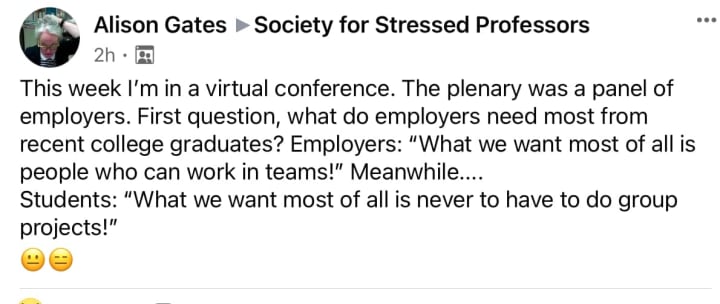Solving the Paradox of Teamwork in Today's College Classroom
In almost every job today, people need to be able to work together effectively. Yet, students hate group projects, and some even avoid taking classes with them. Here's a potential solution with the use of "Mircogroups."

As a “seasoned” business professor who teaches junior and senior-level undergraduates and graduate students, as well as MBA students, one thing is for certain at the beginning of the semester. Whether the class is being taught in a classroom or online or a hybrid of both, students that advanced in their college years are savvy customers. However, they are not like a “Black Friday” shopper looking for “deals” on the syllabus - like that giant screen smart TV for $299…
...and they certainly don’t look at the syllabus for all the possibilities that lie within it, like the “fake” grocery store on “Guy’s Grocery Games!”
No, from experience I can safely say that most students look athe syllabus for what are the “bombs” that might be contained within it, like a big project, a comprehensive final, or the worst thing possible for many of them - at least by perception - a group project!
Yes, those two simple words will instantly strike fear into the hearts of many, if not most, students today! But, why do so many students dislike - and even try and avoid, if possible - classes that have group projects - or even professors that require them to work in teams on any assignments that count for a substantial portion of their course grade? The reasons that I hear from students are varied, but they all seem to center around what are “modern problems.” Students today are jaded by past experiences with group work, where they have seen first hand both the “free rider problem,” which led them to do most - if not all of the work for the group either by themselves or with another group member or two. They are also jaded
by group experiences that ended up in disagreements - or worse - between members, where group projects ended up looking much like this…
...or like this...
In all seriousness, way too many group projects go awry today, often leading not just to very real stress for group members, but sometimes to very tense and even dangerous situations. Further, students today have so many obligations and interests in addition to school between work and family obligations to sports and other pursuits, groups of students often find it difficult to find time to work together on a project outside of class. As we have all learned over the past year and a half during the COVID-19 pandemic, we have great tools for getting together virtually and doing work collaboratively online. But, in the college environment, getting work done by distance has proven even harder than in the corporate world!
And that is the paradox today. However, the comment below, made by a fellow college professor in a Facebook group for higher education faculty, pretty much sums the present state of affairs up:

If a college education can be said to serve any real purpose today - other than being a hoop to jump through and a required element on a resume (which I hate to say, is what how the vast majority of students look upon the experience today), one would hope that it would provide students with a learning ground to be better prepared for the work world, whatever their chosen field may be. And yet, we in higher education are clearing failing - as an industry - in producing the product wanted - and needed - by all employers today, that being students who are well versed in working together in teams to help solve novel problems, to develop creative work products, and to just handle the “issues” that inevitably come up when two or more are gathered - in person or virtually - to work together. From corporate offices to retail stores to hospitals to government agencies to middle schools, every organization wants and needs employees who can, at the very least, “play well together” with their coworkers. And of course, the hope is that some will demonstrate the ability to lead their fellow workers and emerge as the future leaders of that organization.
And yet, today, students really do not want to be assigned group projects and have work to be done in teams. And yes, from the other side of the higher ed equation, professors likewise don’t really want to have to deal with the hassles that today almost inevitably - like 98.9% of the time - come with group projects. I can safely say that over the course of 3+ decades of college teaching, the “failure rate” of groups - not necessarily failing in getting projects done, but in terms of having serious - sometimes very serious - interpersonal issues and conflict occur in student groups has markedly risen over the past decade, and particularly over the past few years. And no, I am not trained to be a psychologist, therapist, or social worker, though I have had countless incidents over the years where I have had to intervene with “groups gone bad.” So yes, college faculty - if surveyed accurately - would likely be just as unenthusiastic about group work and group projects as the students assigned by them to do those assignments.

The “Microgroup” Solution?
Personally, I must say that I am one who “ditched” the big group project in my own classes some time ago. And yes, I teach the kind of management courses where such group projects have historically been the norm. Why did I do so? Simply put: “The juice wasn’t worth the squeeze” - both for students and for myself. There came a point when the negatives - namely hassles and issues involved with students’ - shall we say “group dynamics” - overtook the positive value of the group projects themselves.
So what to do about this disconnect between what the employment market wants and needs in terms of future workers and the present state of affairs when it comes to group work in the college classroom? To me, as a management professor, the answer is clear. Gone are the days of the big, heavily-weighted, semester-long group project. Still, one can - and should - provide students with as many chances as possible to gain what is unquestionably the valuable experience - and learning opportunity - of working with a diverse group of individuals during the course of your course.
And so now, I have gravitated to employing the “microgroup” strategy wherever I can in teaching my classes. What do I mean by microgroups? Simply put, this is dividing the class into randomized groups of students quite often, and sometimes, in most class sessions, in order to have them take on doing small tasks - discussing short cases and coming up with potential alternative strategic options, doing quantitative problems and finding their solutions, engaging in role play exercises based on short scenarios, or simply allowing groups of students to do what would have been homework together in class. However, the group assignments last no more than a single class, and each class session will see students assigned into completely different groups. This gives students the chance to work with many, many different people in their class, and yes, people with whom they may not have chosen to work with in a group, for whatever the reason. I make use of simple techniques to divide my classes - quite often 30-50 people in size - into randomized groups, making use of either random number-based group assignments or, my personal “go to” move, using a deck of playing cards to assign students to groups either based on the cards value, suit, or color (depending on the desired size of the group for the task involved).
While my use of microgroups may not teach the kinds of lessons learned that can be gained from working closely and intensely with a group of students on a semester-long group project as was so common up until a few years ago across higher education, I feel it is a good compromise solution for today’s environment. The microgroup solution enables students to take on a wide variety of tasks and be challenged to work cooperatively with a diverse group of students throughout the semester. And so in some ways, this may provide them with even more experience of working with others than a single, semester-long project done with a static group of individuals. And yes, the microgroup approach may well help better prepare students for today’s work environment, where increasingly, they will need to find ways to quickly adapt to whatever the situation might be and to work effectively with the people they find themselves working with at that time. And thus, I feel fairly confident that the microgroup approach may well both overcome students’ hesitancies about working in groups and provide them with group experiences that will help them - and their employers - in the future.

About David Wyld
David Wyld ([email protected]) is a Professor of Strategic Management at Southeastern Louisiana University in Hammond, Louisiana. He is a management consultant, researcher/writer, publisher, executive educator, and experienced expert witness. You can view all of his work at https://authory.com/DavidWyld.
Social Media Links to David Wyld:
+ on Facebook
+ on LinkedIn
+ on Twitter
About the Creator
David Wyld
Professor, Consultant, Doer. Founder/Publisher of The IDEA Publishing (http://www.theideapublishing.com/) & Modern Business Press (http://www.modernbusinesspress.com)






Comments
There are no comments for this story
Be the first to respond and start the conversation.